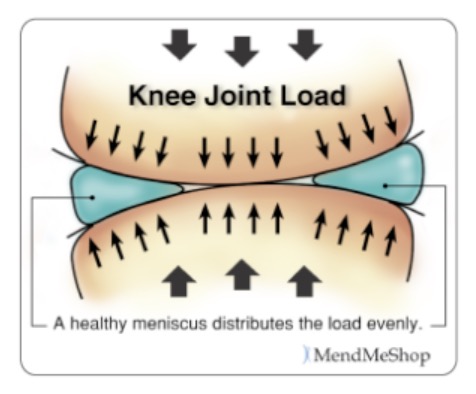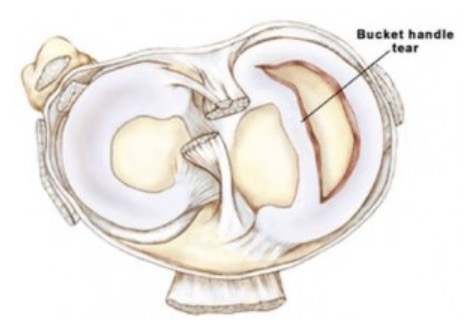What is a Meniscus?
A meniscus is the C-shaped wedge of cartilage found on both sides of the knee, between the thigh bone (femur) and the shin bone (tibia). Each knee has an outer, or lateral meniscus, and an inner, medial meniscus. They act as cushions softening the contact between the femur and tibia when walking or running, whilst also contributing to the stability of the knee. The shape of the end of the thigh bone is concave so the meniscus helps to distribute the force of the thigh bone more evenly.

What is a torn meniscus?
When there is a rupture in the meniscus cartilage it is described as torn. Different parts of the meniscus can be torn in different ways, for example bucket-handle tears.
How does it tear?
There are 2 main ways. They can be torn by a traumatic force during sport but also by relatively innocuous activities such as walking or squatting, usually as part of a degenerative process.

Who gets meniscal tears?
Meniscal injuries are very common knee injuries. They occur in both young and elderly patients, though most commonly occur in active people between 20 and 45 years of age. In the younger age groups, trauma is usually the cause of the tear. Playing sports involving rotational or knee bending activities increase the risk of injury. Alternatively, tears can by due to the meniscus being worn out over many years.
What symptoms would I have?
Tears that have just happened (acute) often cause pain and swelling of the knee, though it is often the day after the injury that symptoms are most pronounced. There can be mechanical symptoms too, such as clicking or locking of the knee where a patient cannot fully straighten their leg.
Often the pain will only be present when the joint is in use, i.e. relieved when rested.
How would it be diagnosed?
During your orthopaedic consultation, history and examination findings would help with the diagnosis. Imaging techniques including X-rays and Magnetic Resonance Imaging would be used to assess the knee and to rule out other serious problems.
How is it treated?
Treatment is often guided by the needs of the patient and the demands that their knee will be put under in the future.
Initial treatment aims to reduce the pain and swelling in the knee. This includes resting the knee, tablet painkillers and anti-inflammatory medications. This would be followed by physiotherapy to strengthen the muscles around the knee.
Not every patient with a meniscal tear necessarily needs surgery. Conservative treatment is tried first. However, if symptoms do not settle down after 6 weeks, or there are persistent painful mechanical symptoms, then surgery is advised.
If the knee is locked due to the meniscal tear, surgery is needed to remove the trapped piece of meniscus as soon as possible.
Arthroscopic repair consists of either stitching the meniscus back in place, or the damaged area may need to be removed.
When would I get back to normal?
You can return to normal daily activities within a few days after surgery. Returning to sport will depend on the type of injury you sustained and will be explained during your consultation, although the time-frame is usually around 6 weeks.